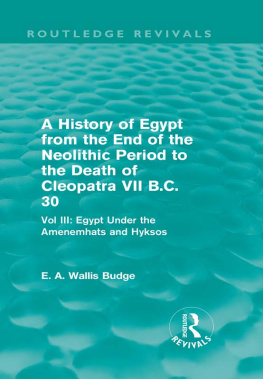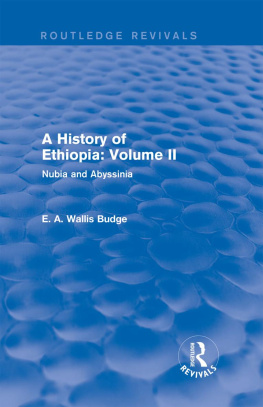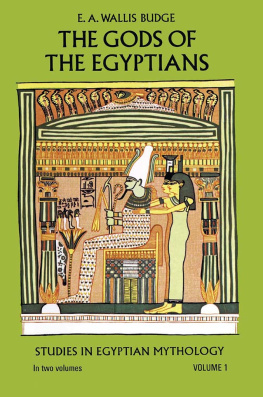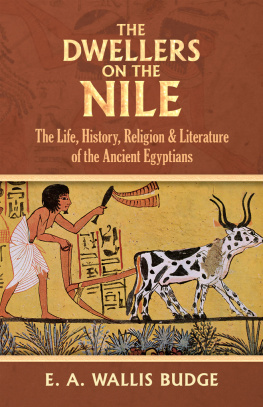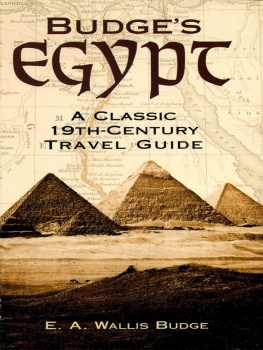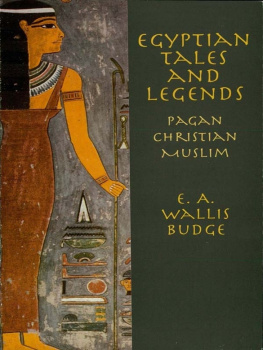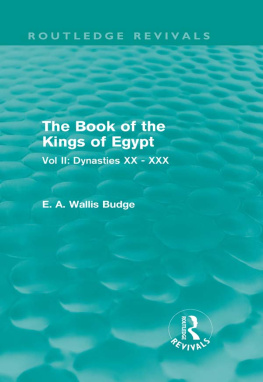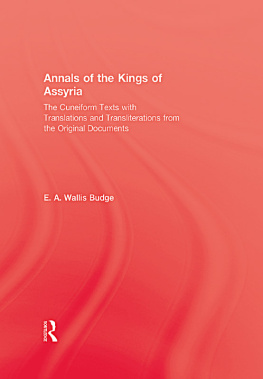Routledge Revivals
A History of Egypt from the End of the Neolithic Period to the Death of Cleopatra VII B.C. 30
Sir E. A. Wallis Budge (1857-1934) was Keeper of the British Museum's department of oriental antiquities from 1894 until his retirement in 1924. Carrying out many missions to Egypt in search of ancient objects, Budge was hugely successful in collecting papyri, statues and other artefacts for the trustees of the British Museum: numbering into the thousands and of great cultural and historical significance. Budge published well over 100 monographs, which shaped the development of future scholarship and are still of great academic value today, dealing with subjects such as Egyptian religion, history and literature.
This volume, first published in 1902, is the third of eight volumes by Budge dealing with different periods in the history of Egypt. The narrative continues from the end of the reign of Seankh-ka-Ra (c. 2500 B.C.), the last king of the XIth Dynasty, to the end of the reign of Thothmes II (c.1550 B.C.). Budge explores this rich and important period of Egyptian history in a classic work of great value to those interested in Egyptology and archaeology.
A History of Egypt from the End of the Neolithic Period to the Death of Cleopatra VII B.C. 30
Vol III: Egypt Under the Amenemhats and Hyksos
E. A. Wallis Budge
First published in 1902
by Kegan Paul, Trench, Trbner & Co. Ltd.
This edition first published in 2013 by Routledge
2 Park Square, Milton Park, Abingdon, Oxon, OX14 4RN
Simultaneously published in the USA and Canada
by Routledge
711 Third Avenue, New York, NY 10017
Routledge is an imprint of the Taylor & Francis Group, an informa business
1902 E. A. Wallis Budge
All rights reserved. No part of this book may be reprinted or reproduced or utilised in any form or by any electronic, mechanical, or other means, now known or hereafter invented, including photocopying and recording, or in any information storage or retrieval system, without permission in writing from the publishers.
Publisher's Note
The publisher has gone to great lengths to ensure the quality of this reprint but points out that some imperfections in the original copies may be apparent.
Disclaimer
The publisher has made every effort to trace copyright holders and welcomes correspondence from those they have been unable to contact.
A Library of Congress record exists under LC control number: 02029270
ISBN 13: 978-0-415-81164-4 (hbk)
ISBN 13: 978-0-203-06890-8 (ebk)
Books on Egypt and Chaldaea
VOL. XI. OF THE SERIES
A HISTORY OF EGYPT
FROM THE END OF THE NEOLITHIC PERIOD TO
THE DEATH OF CLEOPATRA VII. B.C. 30
VOL. III.
EGYPT UNDER THE
MENEMTS AND HYKSOS
PUBLISHERS' NOTE

IN the year 1894 Dr. Wallis Budge prepared for Messrs. Kegan Paul, Trench, Trbner & Co. an elementary work on the Egyptian language, entitled First Steps in Egyptian, and two years later the companion volume, An Egyptian Reading Book, with transliterations of all the texts printed in it, and a full vocabulary. The success of these works proved that they had helped to satisfy a want long felt by students of the Egyptian language, and as a similar want existed among students of the languages written in the cuneiform character, Mr. L. W. King, of the British Museum, prepared on the same lines as the two books mentioned above, an elementary work on the Assyrian and Babylonian languages (First Steps in Assyrian ), which appeared in 1898. These works, however, dealt mainly with the philological branch of Egyptology and Assyriology, and it was impossible in the space allowed to explain much that needed explanation in the other branches of these subjectsthat is to say, matters relating to the archeeology, history, religion, etc., of the Egyptians, Assyrians, and Babylonians. In answer to the numerous requests which have been made, a series of short, popular handbooks on the most important branches of Egyptology and Assyriology have been prepared, and it is hoped that these will serve as introductions to the larger works on these subjects. The present is the eleventh volume of the series, and the succeeding volumes will be published at short intervals, and at moderate prices.
Books on Egypt and Chaldaea
EGYPT
UNDER
THE MENEMTS AND HYKSOS
BY
E. A. WALLIS BUDGE, M.A., LITT.D., D.LIT.
KEEPER OF THE EGYPTIAN AND ASSYRIAN ANTIQUITIES
IN THE BRITISH MUSEUM
ILLUSTRATED
LONDON
KEGAN PAUL, TRENCH, TRBNER & CO. LTD.
PATERNOSTER HOUSE, CHARING CROSS ROAD
1902
[All rights reserved]
LONDON:
PRINTED BY GILBERT AND RlVINGTON, LIMITED,
ST. JOHN'S HOUSE, CLERKENWELL, E.C.
PREFACE

THE period of Egyptian history treated in the present volume has been continued from the end of the reign of Senkh-ka-B, the last king of the XIth Dynasty, to the end of the reign of Thothmes II., i.e., from about 2500 to 1550 B.C. This period is one of the most important in the history of Egypt, for during its course the Egyptians founded their great colony in Nubia, and defeated the Hyksos, and began to extend their possessions into Western Asia. We see the capital of the country now definitely transferred from Memphis to Thebes, the result probably of the difficulty found in ruling the warlike tribes of the south from a city so far to the north as Memphis. The great kings of the XIIth Dynasty, the menemts and the Usertsens, having made firm their hold upon Nubia as far south as the head of the Third Cataract, turned their attention to increasing the material prosperity of the land, which they had re-organized, and which they were ruling with capable hands, by constructing systems ol canals and other irrigation works, the greatest of which was the famous Lake Mris. Such works were, no doubt, carried out by forced labour, but few could complain of this, for they were of public utility, and benefited the community far more than the Pyramids, those mighty monuments of the great kings of the IVth and Vth Dynasties. The Pyramids, however, which were built by the greatest kings of the XIIth Dynasty, though smaller, prove that the hands of the architect and the master-mason had not lost their cunning. The extension into Nubia of the kingdom of Egypt brought with it serious responsibilities and wars with which the immediate successors of the Amenemhats were unable to cope, and during the XIIIth and XIVth Dynasties they had the greatest difficulty in maintaining the integrity of their kingdom against the attacks of the nomadic Semitic tribes on the East, of the Libyans on the West, and of the Nubians in the South. During the XVth and XVIth Dynasties we find that the filthy Hyksos took possession of the Delta, where they began the period of their rule by the wanton destruction of the temples and their gods, but where they finished by adopting Egyptian civilization, and by adding the greatest of their tribal gods, Sutekh, to the companies of the Egyptian gods, Subsequently the ambition of the Hyksos kings aimed at the sovereignty of the whole country from the sea to Nubia, but the attempt which they made to gain it was foiled by the intrepidity of the Theban kings, who defeated them in more than one decisive engagement, and who eventually expelled them from the country. Their departure was the first and greatest Exodus from the Delta, and it became the historic fact around which, in later centuries, the Hebrews hung the traditions of their greatness in Egypt, and their expulsion therefrom. In fact, late writers like Josephus have entirely confused this great Exodus with that smaller Exodus during which the descendants of the Patriarch Jacob were obliged to flee to Palestine. The kings of the XVIIIth Dynasty understood the serious danger with which Egypt wras threatened by the nomadic Semitic tribes of her north-east frontier, and took steps immediately to obtain possession of cities and towns in Southern Syria, from which they could control the movements of the restless and rebellious tribes in the neighbourhood. How they succeeded in effecting their purpose is briefly described in this and in the following volume. Chronologically, however, the period treated in the present section is full of difficulty, and in the present state of Egyptological knowledge no satisfactory account of it can be given. The compilers of the King Lists were themselves hopelessly perplexed, and it is evident that many parts of their chronological systems are entirely artificial. The Turin Papyrus would probably have helped us out of this difficulty, but no reliance can be placed upon it as an authority for constructing the chronology of Dynasties XII.XVII. In spite of recent assertions to the contrary, the remarks by Eosellini, de Roug, Birch, and Wiedemann show that it is useless for critical purposes, first, because of the lacunae in it, and secondly, because the re-joining of many of the fragments by Seyffarth is hopelessly wrong. We can only hope that some fortunate find of papyri may give to Egyptologists an unbroken copy of the work.




